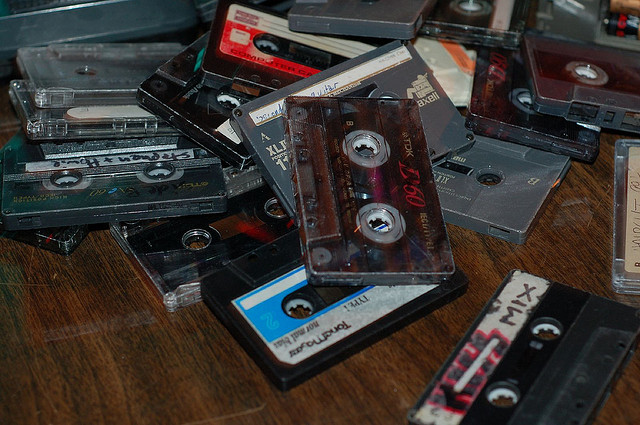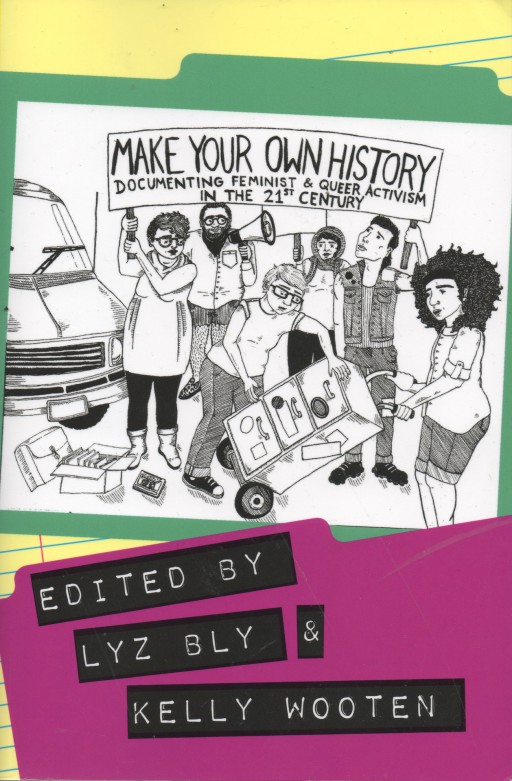(See also the series overview for this Hotspot on civic crowdfunding.)
Kevin Driscoll
Archives have politics and building archives is a political endeavor. To acquire, preserve, curate, and provide access to a collection is to enact a fundamentally simple argument about the material world: some stuff is worth saving, some stuff isn’t, but this stuff right here matters.
In 2009 and 2010, I observed two early Kickstarter projects dedicated to saving large collections of media. Jason Scott successfully raised over $25,000 for the preservation of personal computing artifacts from the 1970s-1990s, while Ben Sisto failed to reach a $6,000 goal to support the digitization of several hundred hours of live video from Boston’s late-1990s/early-2000s DIY/punk music scene. (Full disclosure: these are acquaintances and friends of mine and I enthusiastically backed both projects.) One thing that distinguishes these projects from many other history-related Kickstarters is that they not only listed materials among their costs but specifically requested financial support for their labor. As Scott put it, “Please help me work full time on [computer history] for a few months.”
Shortly after each campaign was announced, a debate emerged among people with a stake in the materials being preserved. Reading the surviving discussions side-by-side, we see potential donors raising very similar concerns about the two projects. Scott summarized the negative responses he received in a pair of reflective posts on his blog:
- Must be nice.
- Someone do that for me next.
- I did a number of quick calculations and here is why this is terrible.
- Here’s a better way to spend that money.
- Here’s my assessment of Jason’s financial situation and life, unhindered by having any direct information.
- Jason sent me an awful e-mail once and here we go with the punchy-facey.
- Everything Jason is doing, archive.org is doing better.
Much of this criticism reflects the fundamental questions behind any archival effort: Is this stuff worth saving? If so, who should do the saving and how should it be paid for?
Participants in the debates surrounding these two projects tended to agree that at least some of the materials were worth preserving. A common sentiment held that the crowdfunding mechanism itself might determine the value of the materials,
“A nice experiment. Will people actually pay other people to preserve something they deem important?”
A minority, however, sarcastically joked that they would rather pay to destroy the collections,
“I will pay a few grand to never have to hear these crappy bands again.”
The principal controversy in both cases centered on the amount of money being requested and the value of the preservationists’ labor. Many commenters argued that Sisto and Scott were over-estimating the cost of building their archives. Some offered cost-saving advice, while others suggested that the burden of running such an archive was too high for an individual to take on. Some of these latter critics speculated, paradoxically, that a for-profit institution might be better positioned to maintain the proposed archives,
“A nice idea but maybe Google will do this in the future?”
In both cases, a forceful argument emerged that the preservation of DIY cultures should not be remunerated at all. They pointed to small collections of materials posted to YouTube and Vimeo as evidence that a distributed archive might somehow arise organically. They used terms like “hobby” to underscore a moral position that this work should remain unpaid. In a few comments, the value of the materials themselves was defined by the willingness of hobbyists to labor without pay:
“If he really cared, he would just do it for free. Any normal fan would do the same.”
Finally, a small number of critics mocked those who chose to donate as suckers and decried the Kickstarters as thinly-veiled scams:
“Hahahaha! Give me free money to do important history things!! Come on, Daddy want a new computer!”
Such barbed comments frequently attacked Scott or Sisto personally for being self-interested and condemed their requests for money as clueless and self-aggrandizing. Although these critics were not kind, they were not necessarily opposed the notion of building an archive. Rather, they preferred that it was carried out by someone else under different a different set of financial circumstances.
Critics who balked at the steep monetary goals set out by Scott and Sisto tended to focus on the labor and cost associated with the short-term acts of collection and digitization. They argued that given enough planning and coordination, this work could be carried out by a team of volunteers. Contributors to Lyz Bly and Kelly Wooten’s collection, Make Your Own History: Documenting Feminist & Queer Activism in the 21st Century (2012), however, emphasize the long-term challenges that accompany an archive intended to last into an uncertain future. While the initial collection of materials may indeed be accomplished on a voluntary basis, institutional support is often needed to maintain accurate metadata and public access over generations.
Janice Radway’s recent work on the “afterlives” of feminist fanzines and zine writers [PDF] helps to illuminate this tension between formal and informal archival labor. Radway began with a re-reading of Stephen Duncombe’s Notes from underground (1997), in which he expressed ambivalence about the potential of zine cultures to effect lasting social change so long as they were defined by the “negative identity” of oppositional punk (e.g., bands with names like Born Against.) Returning to this cohort of zine writers a decade later, however, Radway observed many former zinesters now working along the border between traditional institutions of power and what Duncombe referred to as the “underground.” They are feminist librarians, anarchist archivists, and radical scholars who maintain large zine archives within the existing structures of public libraries and university collections.
DIY archival efforts are often a hedge against an anticipated forgetting. As Alexis Pauline Gumbs notes in her contribution to Bly and Wooten’s book, Black feminists of the 1970s expected to be fogotten, overlooked, and obscured. Their struggle was to “survive long enough” to jump the gap from an ephemeral present to a preservable past. For the predominantly middle-class male hobbyists debating the merits of Scott and Sisto’s projects, the stakes of being forgotten must have seemed a whole lot lower. Many likely reasoned that if those guys weren’t willing to scan magazines and rip videotapes voluntarily, then maybe that stuff wasn’t worth saving. (Of course, whether future fans and scholars would agree is another matter!)
The occasions of Scott and Sisto’s Kickstarter campaigns created opportunities for their communities to debate the value of a shared material history–before the artifacts themselves were destroyed, lost, or forgotten. Notably, the same issues were raised in response to both projects–even though Scott’s campaign was successful and Sisto’s was not. These are important, productive conversations and we should expect to revisit them whenever crowdfunding is taken up to support the production of an archive. As the horizon of history creeps closer, DIY communities will increasingly find themselves asking: what’s worth saving?, who should save it?, and how the heck are we gonna pay for it?
<< back to the series overview for this Hotspot on civic crowdfunding




